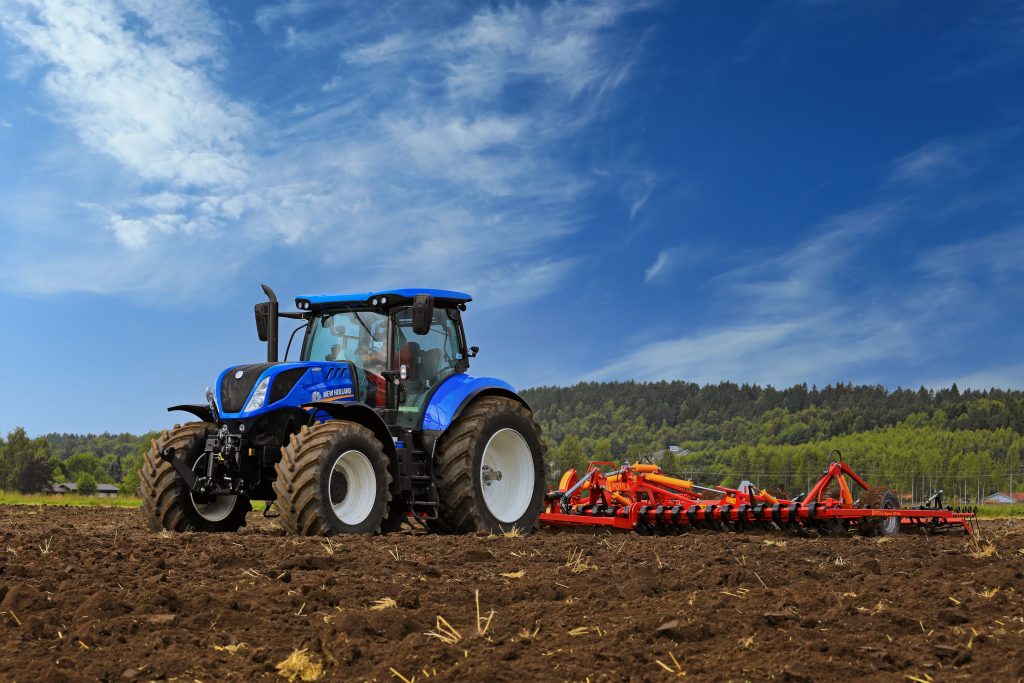Trenance Farm sits at the extreme southwest spit of England, six hours from London and a kicked clod from the Celtic Sea. It’s a dairy farm whose owners, Kevin and Kate Hoare, still milk their cows by hand — 120 bovines, twice a day. But the Hoares are also working with some of the most vanguard climate technology on the planet.
Remember that scene in Back to the Future where Doc Brown pulls up in a flying DeLorean sports car, stuffs a bunch of garbage into it for fuel and blasts off? That, essentially, is what’s happening on the Trenance Farm. It is one of the first places in the world where one can find a tractor that runs exclusively on methane, the completely natural and highly polluting byproduct of pretty much any organic decomposition.
The machine — dubbed the New Holland T6 — weighs 21 000 pounds, boasts 180 horsepower and has as much oomph as a diesel tractor. But its 49-gallon tank spews 62% less nitrous oxide and up to 15% less carbon dioxide, all while running indefinitely on the manure of roughly 75 cows.
“It takes 10 minutes to refuel and we never run out of gas,” Kevin Hoare says. “We might only be a small fish, but at least we’re doing our bit.”
For all its greenery, agriculture is an insidious gusher of greenhouse gas: Heavy-duty equipment emits nitrous oxide and carbon dioxide, while pretty much everything else on a farm — the flora and fauna being raised — spews a continuous cloud of methane, a gas that breaks down naturally over a decade but in the meantime contributes to global warming at a rate 80 times that of carbon. While electrification is increasingly addressing emissions from cars and trucks, it’s less of a fit for farm machinery, because the requisite long hours and intense labour grind batteries down quickly.
That mismatch is what spurred CNH Industrial, an Italy-based rival to John Deere, to start exploring alternative fuels almost 20 years ago. The company latched onto methane because the gas is not only an agent of climate chaos, but on a farm it’s everywhere. While carbon swooned during Covid-19 lockdowns, emissions of methane, which accounts for about 20% of greenhouse gas emissions, continued to climb.
“Electrification has a role … but it’s not likely to replace diesel,” says CNH chief executive officer Scott Wine. “But a medium-sized farm is going to produce more methane than it can use.”
Ironically, the most critical part of the T6 development process had little to do with the tractor itself. CNH needed a means to capture and process that methane, which it found in a startup called Bennamann Ltd. Since 2011, Bennamann has been making synthetic fabric domes, or membranes, that stretch over manure lagoons and capture wafting gas like a tented parachute in gym class. CNH bought a controlling stake in the company this year.
“I think it’s the fastest path to a $1 billion business I’ve ever been around,” Wine said of Bennamann.
A critical ah-ha moment came when Bennamann co-founder Chris Mann realised he could use some of the captured gas to cool the rest, in a process not unlike that found in a propane-fuelled refrigerator. When methane is cold enough, it becomes a liquid, which is far easier to transport and for an engine to work with. The company equipped its T6 engine with a turbo system and finely tuned the tractor’s combustion for methane. As a result, any farmer with a Bennamann dome can pull their T6 up to the Bennamann digester and fill it like a car at a gas station. One dome can store a month’s worth of gas, which can be processed into fuel in about four days.
“We call it the magic factory,” Mann says. “Organic waste goes in and the gas comes out. There’s no heat; it’s just nature doing its thing.”
The T6 does have its downsides: It costs $203,000, roughly 30% more than an equivalent diesel tractor, though CNH says that premium is covered in less than a year of refills via cow. Customers with a methane surplus can also sell the gas, burn it in a generator or even send juice back to the grid. On some Bennamann farms, the manure makes more money than the milk and meat.
For now, CNH is pushing its tractor and manure tent as a package, focused primarily on dairy farms in Europe. (In the UK alone, there are about 12,000 farms with at least 75 cows.) But a similar setup would work virtually anywhere there’s a font of methane, from landfills to fish markets. Rice patties, for example, are a massive source of methane.
On the Trenance Farm, the T6 runs up to 10 hours a day — rolling, plowing, harrowing, hauling, cutting, feeding and of course scraping heaps of cow poop into a pit. It has already had a significant impact: The farm is burning about 100 fewer gallons of diesel each month, the equivalent of 1 080 kilograms of carbon emissions (what a passenger car spews every three months). It’s also tenting so much methane that the Hoares started using the excess gas to power a generator, which in turn churns out enough electricity to juice the entire farm.
For years, Hoare has been bugging the local utility for enough voltage to install an automated milking system; now he doesn’t have to. The cows, in a way, will milk themselves.
“It’s a closed loop,” he says. “We’re totally off-grid, we’ve got our own water supply and honestly, the whole place smells better.”
© 2023 Bloomberg

